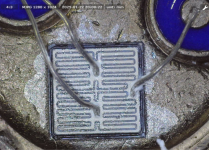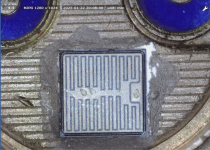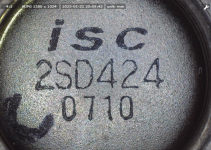It seems odd seeing the number split between two lines.
BC
560C
Would be valid.
You obviously have doubts... eBay?
BC
560C
Would be valid.
You obviously have doubts... eBay?
To me they look authentic Onsemi bc560CG transistorsThey should be onsemi.
Can you confirm or deny this?
Thank you.
I'm not sure if those are from Onsemi but by looking at them I think they're of good quality or from major manufacturers.
A bit off-topic: some die-shots of very old and new ISC/Inchange 2SD424s attached.
As you can see, the die itself has changed, both versions use heatspreaders (new one definitely worse surface quality), as well as two bonding wires for the emitter. The old die measures appr. 5,2mm, the new one 5,7mm in both dimensions.
Both were purchased from Reichelt.de, although some 12yrs. apart.
Now they sell them for €2,42 wich is a bit expensive, compared to that Reichelt.de currently sells original 2SA1941/2SC5198 for €1,21. And yes, I have no doubt that they are original Thoshiba.
kessler-electronic.de offers some CDIL 2SD424s, I'll get some of these too.
Bottom line - definitely much better than some of the ebay stuff:

As you can see, the die itself has changed, both versions use heatspreaders (new one definitely worse surface quality), as well as two bonding wires for the emitter. The old die measures appr. 5,2mm, the new one 5,7mm in both dimensions.
Both were purchased from Reichelt.de, although some 12yrs. apart.
Now they sell them for €2,42 wich is a bit expensive, compared to that Reichelt.de currently sells original 2SA1941/2SC5198 for €1,21. And yes, I have no doubt that they are original Thoshiba.
kessler-electronic.de offers some CDIL 2SD424s, I'll get some of these too.
Bottom line - definitely much better than some of the ebay stuff:
Attachments
Last edited:
That “Toshiba” D424 is an obvious fake - doesn’t even matter what it looks like inside it the top hat just pops off. Even real innards wouldn’t last.
The ISC dies look plausible. Is it as good? Might be, might not be. Original is only 6 MHz, and an MJ15024 die would pass as a D424. It’s old technology, they might be able to copy it. And the “new” die does look like a better layout with two symmetric emitter regions like the original D424 did. We know their copies of Sanken LAPTs to be lacking, but if they can make something like an MJ15024 it would do the deed. Speed can usually be traded off for ruggedness, and the package looks to be up to snuff as a 150W TO-3.
The ISC dies look plausible. Is it as good? Might be, might not be. Original is only 6 MHz, and an MJ15024 die would pass as a D424. It’s old technology, they might be able to copy it. And the “new” die does look like a better layout with two symmetric emitter regions like the original D424 did. We know their copies of Sanken LAPTs to be lacking, but if they can make something like an MJ15024 it would do the deed. Speed can usually be traded off for ruggedness, and the package looks to be up to snuff as a 150W TO-3.
Chris, agree with you on that. Need I go out on a limb and add NTE parts to that list. I never sub their parts, which are “ approximate” subs.
Sadly many good production parts are going the way of the dodo. The Toshiba D424 are similar tech to the 21193/4/5/6, not the motor control parts known as the MJ15022/3/4/5. I hope they kill off the 1502x series but keep the 2119x series which can cover for many older parts and are just as rugged.
Sadly many good production parts are going the way of the dodo. The Toshiba D424 are similar tech to the 21193/4/5/6, not the motor control parts known as the MJ15022/3/4/5. I hope they kill off the 1502x series but keep the 2119x series which can cover for many older parts and are just as rugged.
NTE, ECG. Those are floor sweepings and who knows what the original numbers were supposed to be. I used to work for a company that sold ECG parts. Let's just say they were not very good from a quality / failure standpoint. TV guys were happy with them.
I used to stock 2SD424 and 2SB554, also 2SD555 and 2SB600 as standard outputs. A few others, but these went into most repairs. You move on to newer numbers when they discontinue your favorites. It's a pain to find new suitable parts. The MJ1502x parts weren't bad, it was the MJ15016/MJ15016 that were garbage.
I used to stock 2SD424 and 2SB554, also 2SD555 and 2SB600 as standard outputs. A few others, but these went into most repairs. You move on to newer numbers when they discontinue your favorites. It's a pain to find new suitable parts. The MJ1502x parts weren't bad, it was the MJ15016/MJ15016 that were garbage.
Err do you have 424/555/554/600’s 😊. I always need some.
Yes the 1502x were not garbage, but a bit strident and metallic sounding. I could tell comparing the 555ii’s that had Toshibas vs the Adc parts.
Mot said themselves they were designed for motor control , quite surprised when they were used in Audio and sounded good ( only when biased very high)
Yes the 1502x were not garbage, but a bit strident and metallic sounding. I could tell comparing the 555ii’s that had Toshibas vs the Adc parts.
Mot said themselves they were designed for motor control , quite surprised when they were used in Audio and sounded good ( only when biased very high)
what i do not like at reichelt is that they do not write down the hfe group what they offer!So, just because I've mentioned it, a comparison of the 2SC5198:
View attachment 1411303
I honestly can't remember from what amplifier I've pulled the right ones (maybe Thomann T.Amp T4-700... idk but for sure min. 5yrs ago).
For €1,2 they are a steal.
I'll brake one open.
kr
chris
I have a couple 2SD424 and 2SB554 for a couple of my own amplifiers left.
As wg_ski said, they were very linear devices and also very rugged. Being fast transistors you have to adjust the feedback compensation if you simply install them where another number was used. They should sound identical, it's the amplifier response that changed. I check with a square wave and use RF trimmer caps to find the right new value, hen install something close as a fixed capacitor(s).
As wg_ski said, they were very linear devices and also very rugged. Being fast transistors you have to adjust the feedback compensation if you simply install them where another number was used. They should sound identical, it's the amplifier response that changed. I check with a square wave and use RF trimmer caps to find the right new value, hen install something close as a fixed capacitor(s).
Theres more to it than compensation for those 15024/5's, they never sounded right to me, not in a KSA-250 and not in the 555. Both sounded steely and metallic in the upper mids. Yes they are workhorses, but little in the way of comfort and finesse. The 2119x are better.
“Steely, metallic”, or “overly bright” is a symptom of severe square wave overshoot. Any time I hear it I see it. If it is happening the compensation needs adjustment. Initially, you might like the added detail and “air”, but listen long enough you’ll be ready to break all the windows. Adjust the lead compensation so that it doesn’t do it anymore and the fatiguing sound goes away like magic. If you need to adjust it far enough that the closed loop response falls off below 20kHz the output/driver transistors aren’t fast enough (or the design just won’t support the GBW you want).
Agreed, and precluding other reasons might limiting the cause to just compensation. You bias these suckers deep into class A and they sound better, there has to be more. One seasoned designer once told me it has to do with the crystalline nature of silicon wafer. It resonates differently (harmonic portfolio) based on temperature and current flowing through them. Both his reasons bear out my listening experiences with them, high bias fulfills both requirements. Compensation might be well behaved, or not for this additional variable to affect sonics. I am not arrogant enough to disregard your assertion on compensation as a reason for steely sound. I will keep it in mind.
Biasing into class A gets you away from the beta fall off at LOW current that is associated with all epitaxial base NPN power transistors. PNPs have a different profile, and if you want/need it to match it’s got to be biased relatively high. Or use a topology that doesn’t rely as heavily on output tranny beta or matching.
Yes, it isn't the bias level but the linearity of the output stage. Really it comes down to the overall transfer function and distortion signature (spectrum, not just numbers). Certain designs can cancel output stage distortion better than others. That is assuming you can deliver the required current to the load when needed.
- Home
- Design & Build
- Parts
- My Transistors, original or copy?



